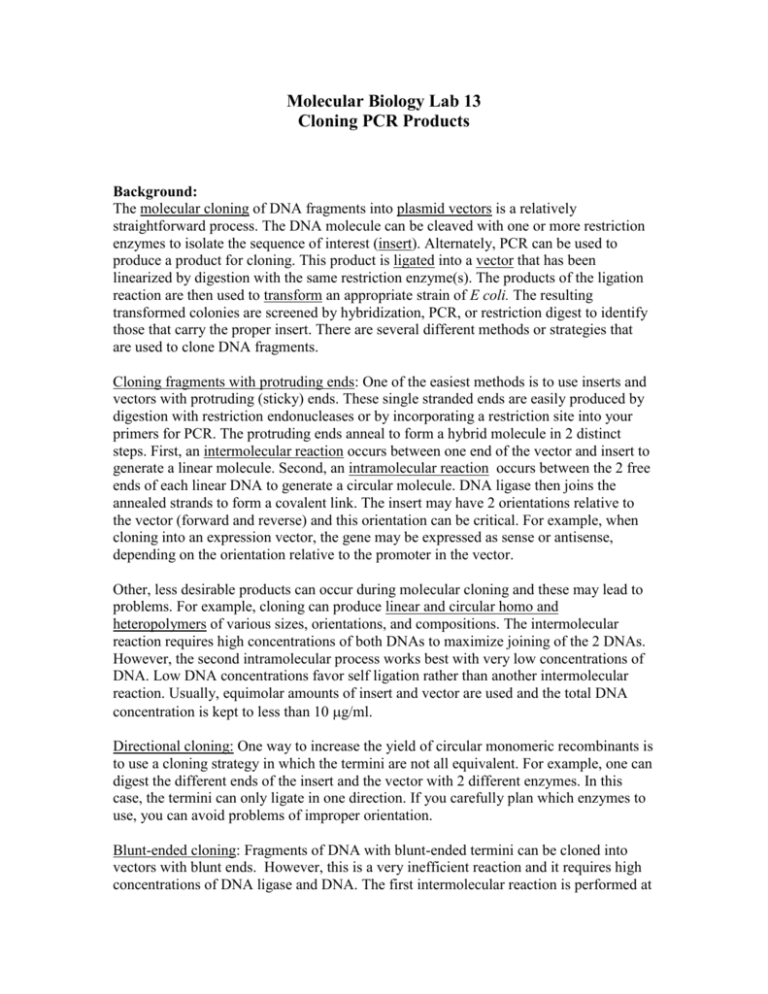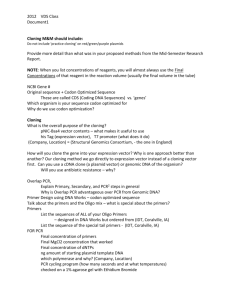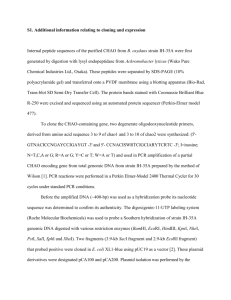Molecular Biology Labs 16-17
advertisement

Molecular Biology Lab 13 Cloning PCR Products Background: The molecular cloning of DNA fragments into plasmid vectors is a relatively straightforward process. The DNA molecule can be cleaved with one or more restriction enzymes to isolate the sequence of interest (insert). Alternately, PCR can be used to produce a product for cloning. This product is ligated into a vector that has been linearized by digestion with the same restriction enzyme(s). The products of the ligation reaction are then used to transform an appropriate strain of E coli. The resulting transformed colonies are screened by hybridization, PCR, or restriction digest to identify those that carry the proper insert. There are several different methods or strategies that are used to clone DNA fragments. Cloning fragments with protruding ends: One of the easiest methods is to use inserts and vectors with protruding (sticky) ends. These single stranded ends are easily produced by digestion with restriction endonucleases or by incorporating a restriction site into your primers for PCR. The protruding ends anneal to form a hybrid molecule in 2 distinct steps. First, an intermolecular reaction occurs between one end of the vector and insert to generate a linear molecule. Second, an intramolecular reaction occurs between the 2 free ends of each linear DNA to generate a circular molecule. DNA ligase then joins the annealed strands to form a covalent link. The insert may have 2 orientations relative to the vector (forward and reverse) and this orientation can be critical. For example, when cloning into an expression vector, the gene may be expressed as sense or antisense, depending on the orientation relative to the promoter in the vector. Other, less desirable products can occur during molecular cloning and these may lead to problems. For example, cloning can produce linear and circular homo and heteropolymers of various sizes, orientations, and compositions. The intermolecular reaction requires high concentrations of both DNAs to maximize joining of the 2 DNAs. However, the second intramolecular process works best with very low concentrations of DNA. Low DNA concentrations favor self ligation rather than another intermolecular reaction. Usually, equimolar amounts of insert and vector are used and the total DNA concentration is kept to less than 10 g/ml. Directional cloning: One way to increase the yield of circular monomeric recombinants is to use a cloning strategy in which the termini are not all equivalent. For example, one can digest the different ends of the insert and the vector with 2 different enzymes. In this case, the termini can only ligate in one direction. If you carefully plan which enzymes to use, you can avoid problems of improper orientation. Blunt-ended cloning: Fragments of DNA with blunt-ended termini can be cloned into vectors with blunt ends. However, this is a very inefficient reaction and it requires high concentrations of DNA ligase and DNA. The first intermolecular reaction is performed at high DNA concentration, whereas the second intramolecular reaction must be performed at low concentrations to be effective (to avoid polymers). Usually, the first reaction is performed at high DNA concentration, the reaction is diluted 20-fold, and the second reaction is performed. Blunt-ended DNA fragments can be cloned more efficiently using synthetic linkers or adaptors purchased from biotech companies. A linker is a short stretch of DNA that contains a restriction enzyme recognition sequence. These are available for many restriction sites. They are ligated to the insert using very high concentrations of ligase and linker. They are then digested with the appropriate enzyme to generate sticky ends. Following this, they are ligated to a vector that has been predigested with the same enzyme. Adaptors are similar, however, they are purchased as ‘ready to ligate’ DNA fragments with one sticky terminus (which can be ligated to vector) and one blunt end (which is ligated to the insert). The linkers or adaptors often contain sites for restriction enzymes that cut very infrequently in mammalian DNA (NotI and SalI cut once every 100 – 1000 kb). This makes it unlikely that the added restriction site is also present in the vector or insert (which would create problems if one were interested in cutting out the intact insert). Cloning PCR products: Many methods have been devised for cloning products of PCR reactions. One problem is that the Taq polymerase used for PCR has a template independent terminal transferase activity. It adds a single unpaired nucleotide to the end of the PCR product and this can inhibit cloning. Several useful methods include: 1. Cloning blunt-ended PCR products. Some thermostabile DNA polymerases (Pwo and Pfu) lack terminal transferase activity and generate suitable blunt end fragments for cloning. This method is much less efficient than others. 2. Addition of restriction sites to the 5’ termini of primers. These sites are transferred to the PCR products during amplification. If you use 2 different sites (one on each primer) you can clone directionally. This method is much more efficient. 3. T vectors contain a single thymidine at each 3’ end. They are used for cloning PCR products that have a single adenine at the end (caused by the terminal transferase activity of Taq). A single unpaired T and A are enough to stabilize the strands and this leads to a cloning efficiency 50X greater than blunt end cloning. TOPO TA Cloning System: This is a commercially available kit that will be used in this lab. It uses a Taq polymerase to generate PCR fragments with an A overhang at each end. The kit comes with a linearized vector that contains single overhangs of T at each end. No DNA ligase is necessary to join fragments. The linear vector comes with a topoisomerase molecule attached. Topoisomerases are enzymes that cleave the phosphodiester backbone in one DNA strand. The energy from the broken bond is conserved by formation of a covalent bond between the 3’ phosphate and the topoisomerase enzyme. This bond between enzyme and the 3’ phosphate can be attacked by the 5’ hydroxyl of another DNA strand, reversing the reaction and releasing the topoisomerase. This results in covalent attachment of insert and vector DNA without the need for DNA ligase. Objectives: The objectives of this lab are (1) to learn about the different methods for cloning PCR products and (2) to clone PCR products in lab using the TOPO TA Cloning method. Materials: TOPO TA cloning kit (InVitrogen Corp.) containing T vector and other components required for cloning including the pCR2.1-TOPO vector, 10X PCR buffer, salt solution, -T1 Competent cells (1 vial/transformation), SOC medium. Samples of cellular DNA PUC19 control DNA 37C shaking incubator 42C water bath LB agar p X-gal (40 mg/ml) Spreaders for bacteria Disposable gloves Microcentrifuge Thermocycler Thin wall PCR tubes PCR primers PCR supermix or PCR reaction components Miniprep kit for DNA purification Micropipetters Sterile eppendorf tubes, yellow tips, and blue tips, eppendorf racks Sterile deionized water Glycerol and cryotubes for making stocks of overnight cultures LB broth and antibiotic for overnight cultures Methods: PCR reaction. 1. Set up a PCR reaction using high molecular weight cell DNA. Add approximately 1 g of DNA, 2 l of each primer pair, and 45 l of PCR supermix to a PCR tube on ice. Mix components and place in thermocycler. As a positive control, use 1 l of control template DNA from the kit along with 1 l of each primer. Amplify under the following conditions: denaturation at 94ºC for 2 min, then 30 cycles of 94ºC denaturation for 1 min, annealing at 55ºC for 1 min, and extension at 72ºC for 1 min. 2. Program the thermocycler for the proper PCR reaction conditions, and run samples to amplify template DNA. Be sure to include a 7 to 30 min extension at 72ºC after the last cycle to ensure that all PCR products are full length and 3’ adenylated 3. Pour a 1.4% agarose gel containing 0.5 g/ml ethidium bromide in 1X TAE buffer. Allow to polymerize for at least 30 min. 4. Add 10 to 20 l of your PCR reaction to an eppendorf tube and mix with blue juice gel loading buffer (4 l/20 l of DNA solution). Run agarose minigel at 60V to visualize the DNA bands. You should obtain a single band of PCR product. Set up the TOPO TA cloning reaction. 5. Equilibrate a water bath to 42ºC 6. Warm a vial of SOC medium to room temperature and the agar plates to 37°C temp. for 30 min. Use 2 plates for each transformation. 7. Spread 40 l of 40 mg/ml X-gal on each LB plate and incubate at 37°C until ready for use. 8. Thaw the competent cells (DH5-T1) on ice. Do not place at 37ºC. 9. Add 0.5 to 4 l of fresh PCR product, 1 l of salt solution, and bring the volume to 5 l with sterile deionized water. Add 1 l of TOPO vector to the 5 l reaction and mix gently. Include a positive and negative control (see below). reagent fresh PCR product control PCR product salt solution sterile water TOPO vector final volume experimental 0.5 – 4 l 1 l up to 5 l 1 l 6 l Pos. control 1 l 1 l 3 l 1 l 6 l Neg control 1 l 4 l 1 l 6 l 10. Incubate the cloning reactions. For some purposes, 5 min at room temperature is sufficient. Increasing the time of reaction to 30 min will result in more colonies. 11. Place the reaction on ice. You can store the TOPO cloning reaction overnight at -20ºC, or you can proceed immediately to the transformation of E coli. 12. Add 2 l of the TOPO cloning reaction into a vial of competent cells and mix very gently by swirling the yellow tip. Do not pipette up and down to mix. 13. Incubate on ice for 30 min. 14. Heat shock the cells for 30 seconds at 42ºC without shaking. 15. Immediately transfer the tubes to ice. 16. Add 250 l of SOC medium at room temp. Cap the tube and shake for 1 hour at 37ºC in a shaker incubator (200 rpm). 17. Spread 10 to 50 l from each transformation on a prewarmed selective plate and incubate overnight at 37ºC. Use ampicillin plates for the PCR products that you generated and kanamycin plates for the positive and negative control. Plate 2 different volumes to ensure that at least one plate will have well spaced colonies. An efficient TOPO cloning reaction should produce many colonies. Most colonies should be white. 18. Pick the white colonies for analysis as these should have the insert. The dark blue colonies have -galactosidase activity and these lack the insert. 19. Grow several white colonies overnight in 5 ml of LB medium containing 50 g/ml ampicillin or kanamycin. 20. Prepare a glycerol stock for long term storage. Streak the original colony out on an LB agar plate containing 50 g/ml of ampicillin. Isolate a single colony and inoculate into 1-2 ml of LB medium with antibiotic and grow overnight. Mix 0.5 ml of culture medium with 0.5 ml of glycerol solution and add to a cryovial. Place in the -70ºC freezer.








